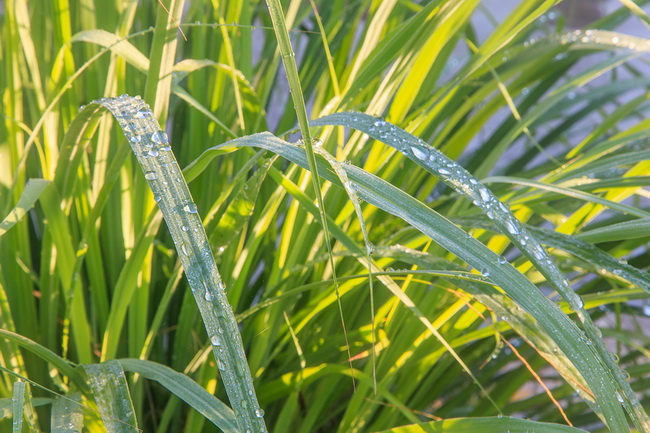- Make It Yourself Lavender Heart-Shaped Bath Bombs!
- 20 Things You Never Knew About “Down There”
- 12 Best Foods For Those Suffering From Arthritis Pain
- 12 Personal Hygiene Mistakes Almost Everyone Makes (Mom Never Told You About #4!)
- 15 Medicinal Plants And Herbs From The Cherokee People
- 12 Mind-Blowing Benefits Of Drinking Coconut Water During Pregnancy
- 12 Outstanding Winter Foods That Won’t Fatten You Up Like A Christmas Turkey
How to Grow and Use Lemongrass

Photo credit: bigstock.com
You might have seen various items in stores that had “lemongrass” scent or perhaps you have seen reed diffusers scented with lemongrass. Have you ever looked at those things and wondered, what exactly is lemongrass anyway?
Lemongrass (cymbopogon citratus) is an herb that belongs to the grass family. It is a very common herb used for its very distinct lemon flavor and aroma. This plant is native to India. It’s a coarse, tufted type of plant with thin leaves that grow in thick bunches with plants that stand about 9 feet in height and 3 feet in width.
Lemongrass is often used in cooking dishes but it can also offer us plenty of medicinal benefits. Lemongrass has anti-fungal, antimicrobial, and antibacterial compounds.
Lemongrass is also loaded with flavonoids, phenolic compounds such as quercetin, luteolin, glycosides, and antioxidants, all of which are known to be disease preventative agents. The main active ingredient in lemongrass, lemonal or citral, is what gives lemongrass its unique scent as well as many of its health benefits.
Some of the health benefits of lemongrass include:
- Anti-Cancer Compounds – Research shows that lemongrass has great promise in the area of skin cancer activities. It can inhibit the growth of hepatic cancer cells and prevent further production of cancerous cells.
- Edema – Lemongrass can stop excessive water retention in the body, which is called edema. It has a cleansing effect on the lymph system, which can relieve swelling.
- Cholesterol – Supports healthy cholesterol levels in the body.
- Detox – This herb is superb at cleansing and flushing toxins from the body. Find out other detox and cleanse foods.
- Stops Infection – Studies show that lemongrass essential oil can help fight against staphylococcus aureus. Lemongrass interrupts the communication and growth of germs, which helps in the inhibition in the formation of biofilms.
- Helps with Insomnia – The sweet, citrusy scent of this herb is soothing to the nerves and muscles, which can help induce a deeper, more restful sleep.
- Fever – You might hear lemongrass referred to as fever grass, since it has super beneficial effect when it comes to lowering fevers. Lemongrass is often used in Ayurvedic medicine for stopping fevers by inducing sweating.
Continue to Page 2

Photo credit: bigstock.com
Are you interested in growing your own lemongrass plant?
It’s easier than you think! If you live in a location with mild winters, you can plant some in your garden. If you have more harsh winters, keep it in a large pot that you can move into a garage or covered patio area to overwinter.
Don’t bother buying seeds. This plant takes a very long time to grow from seeds, as long as 3 months just to germinate! If you don’t know anyone with a plant, you might be able to start a new plant from stalks you buy at your local farmers’ market. As long as the stalks are still green and firm, you can more than likely get them to take root.
Cut an inch or two off the end of the leaves and put it in a glass of water. Place in a sunny location or a sunny window. Soon, you should see roots coming from the base within 2 weeks. If not, try again with a new piece. This is successful almost all the time.
Once the roots are at least an inch long, it is ready for planting. You can place it in a pot, or put it outside in the garden.
If you decide to plant your lemongrass outside, and find you love it so much you want more, space them at least 3 feet apart. Expect your lemongrass to grow at least 6 feet in height. You can trim them down, but the new shoots do need room to grow.
SEE ALSO: Top Fruits and Veggies You Can Regrow at Home Over and Over Again!
Lemongrass needs plenty of nitrogen. Fertilize once a month and don’t let your plant become too dry, especially if you have hot summers.
If you plant your lemongrass in pots, they can grow to be quite large, so use at least a 5 gallon pot. If it starts to outgrow the pot, you can simply remove stalks to keep it under control.
Lemongrass needs a minimum of 6 hours of sunlight each day. It does grow inside near sunny windows but it won’t grow very many stalks. You can fertilize container pots every two weeks with just a standard fertilizer mix but skip it during the winter months to avoid growth. Be sure you water frequently, especially in hot weather.
One of the great things about lemongrass is that it is often used as an insect repellant, so you won’t have any pests to worry about, other than something called leaf blight. It’s not a pest, but a type of fungus. If you find your leaves drooping or wilting, and they have brownish or rust colored leaves, you probably have leaf blight. Cut off and remove every infected leaves, then spray the plant with a natural fungicide that is suitable for edible plants.
If you have cats, be aware that they like lemongrass and might chew on the leaves. It won’t hurt them, but if it’s a potted indoor plant, they might knock the plant over.
Once your plant grows at least 12 inches tall, you can begin to trim leaves. If you want to harvest the entire stalk, use a very sharp knife and cut it off right at the soil level. Take outer stalks first. They should be at least ½ inch thick for harvesting. Always cut off stalks or leaves, breaking them can damage the plant.
You can store a fresh stalk in your refrigerator for several days, wrapped in a damp paper towel. Alternately, you can dry the leaves, chop them, and then store them in an airtight container.
You can cook with your fresh lemongrass, but only use the white core part of the plant. You can use the leaves to make lemon tea. The easiest way to use lemongrass in cooking is to use a muslin bag. Place the chopped up pieces of lemongrass in the bag and add it to the water when cooking rice or any other dish, then remove the bag when you are ready to serve. This will give you the lemon flavor without the hard pieces of stalk being in your food.

































